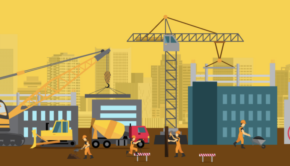High-Rise Buildings: 4 Challenges Engineers Face
Buildings and high-rising skyscrapers add to the personality of any growing metropolitan. These complexes give cities a much more attractive look and can be the sole reason for increased tourism. This is why places like Paris and Dubai, which are known for their buildings and design, manage to bring in thousands of people annually. After all, they managed to construct challenging structures like the Burj Khalifa and the Eiffel Tower.
However, this is only possible because of the talent behind these projects. Expert civil engineers put a long thought process into making these buildings stylish, unique, tech-friendly, and above all, able to stand firmly without collapsing for years. So how do these experts do it, and what challenges can they face while trying to build another successful project from ground zero? Here’s what you need to know:
Why Are High-Rise Buildings Useful?
There are many advantages to constructing high-rise buildings over one-story houses. Apart from adding aesthetics to any thriving city, these complexes can accommodate hundreds of people at a time which is an effective solution against the population boom. These tall buildings are also ideal as business centers, allowing organizations to use the area adequately. This is only possible with the help of talented and highly skilled civil engineers. The skills, knowledge, and technical understanding these professionals possess can help build an impressive-looking infrastructure that complements any modern city.
Consequently, this profession is not only highly celebrated but extremely important in laying down the groundwork for prestigious construction projects. So if you wish to try your hand in this field and test the limits of your imagination, you have a long road ahead of you. Start by acquiring a bachelors civil engineering degree to get a rudimentary understanding of science, math, and construction basics.
After this, you may need to continue studying till your master’s and clear your engineering exams to ensure you become a certified expert. Once you have the required qualifications, you are ready to start working, creating, and building.
What Challenges Can Occur While Erecting A High Building?
Designing a high-rise building is not like stacking legos. There is more to building one floor on top of another until you feel the project is tall enough. Before you begin outlining a blueprint, you must worry about several logistics for constructing any large-scale project. These may include the amount of raw material required, environmental hazards, and whether the new complex is sustainable in the long run.
The end goal of any professional civil engineer is to bring only those buildings into fruition that add value to the economy and look appealing. Hence here are some common challenges that you may face:
The Fast Moving Wind
Wind speed increases the higher you go in altitude. This is why when you climb the peak of a mountain; you’re greeted with furious winds that can sweep you away. Therefore when constructing a large building, it is essential to account for this natural phenomenon. The fast-blowing air can be uncomfortable and scary for people who use the top floors. The intense pressure and noise these currents produce don’t improve the situation.
Hence for any civil engineer, the only way to combat this situation is to design an aerodynamic shape that can guide the wind from one end of the building to the next without disturbing residents. This is a calculated technique that involves creating article vertices and using simple geometry that can withstand the force of air and safely divert it away from the building.
Accounting for Fire Safety
Fires can break out anytime and rise like a crescendo that can quickly spread to the upper levels. If a fire breaks out when a project is still underway, it can lead to immense damage that may cost a hefty amount to repair. When designing a building, it is essential to list potential fire hazards and work on removing them. Likewise, you also have to ensure that construction workers have a safe passage allowing them to evacuate the area in case of a fire. So before you start, always choose raw materials that are not flammable, preventing construction workers from endangering themselves.
You should also ensure that the project manager has arranged fire safety equipment on site and outlined how workers should escape from an under-construction building in case of an outbreak. You can also discourage workers from tending to their job when the weather is too hot in the morning and ask them to resume at night. The warm weather impacts machines and equipment, causing them to become too dangerous to handle.
Aesthetics are very important
A building needs to look attractive. Aesthetics plays a vital role in infrastructure as it makes the product look good and encourages people to consider buying residential or commerical areas within the building. There is a reason why Victorian-style buildings and gothic manors still attract thousands of tourists yearly, even if they are nothing more than abandoned structures. Therefore, you need to conceptualize a project that is both functional and has a beautiful finish. In such cases, you should use 3D software that allows you to create images that can inform you if the project is doable.
It is also much easier to explain your vision to construction workers when you can draw a prototype they can use. However, even if your initial design gets approved, you need backups. This is because not every project gets completed on time, and the added delay can add to the overall cost. As a result, you may not have enough to carry on with the original design and need to modify the structure so that it falls in line with the remaining budget.
Dealing With Dampers
High buildings tend to sway. Even if they move discreetly, there is minute shaking involved in these structures. Minimal swaying doesn’t cause structural damage, which is why they’re not too concerning. But when high-speed winds and earthquakes get added to the equation, there is a greater chance the building may collapse. This is why it is vital to have dampers in place. These devices are strategically placed in the building to absorb the shock and ensure vibrations don’t rattle the structure.
Final Thoughts
Modern infrastructure is crucial for any growing and thriving city, so civil engineers have an essential role to play. The job you do ensures that the buildings you design are sustainable and can stay in place for a long time without collapsing. But this is not easy to achieve, especially with high-rise towers. Tall structures need to be studied before you can work on them.
This is because these structures are prone to numerous challenges, such as high winds, far too much swaying, and a possible outbreak of a fire that intervenes with its construction. You also need to know how to design a modern and aesthetically pleasing project that is not too costly to execute. Consequently, balancing all these factors can make working with tall buildings quite tricky. Adequate education and practical experience are what every civil engineer needs before taking up such a challenging project.
Cover Image Source
















